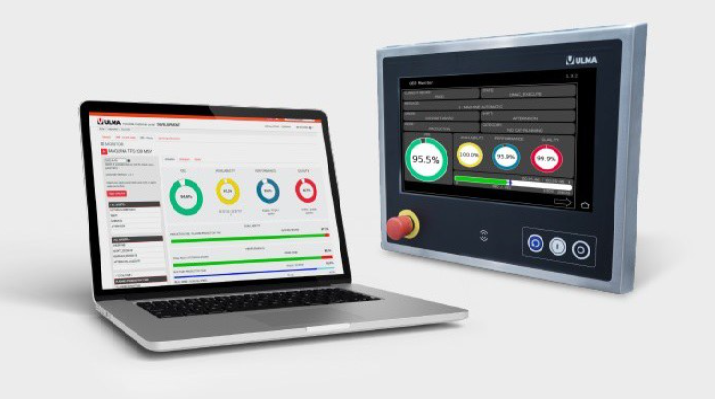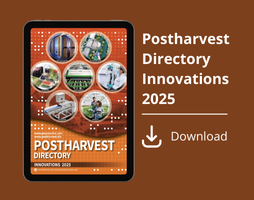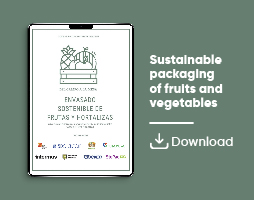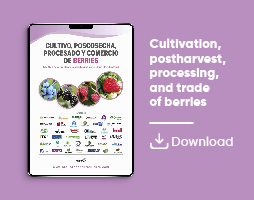Actualidad
Review about Deep Eutectic Solvents, a Green Alternative in Postharvest
The paper "Deep Eutectic Solvents as Green Alternatives in Postharvest Fruit Preservation: a Comprehensive Review", by M. J. Gidado, Ahmad Anas Nagoor Gunny & Inas M. AlNashef, is a deep review about all the aspects related to DESs, and is fully available for free

Redaccion
Postharvest fruit losses remain a critical challenge in global agriculture, prompting the search for sustainable and eco-friendly preservation strategies.
Deep eutectic solvents (DESs), a novel class of green solvents composed of biodegradable components, have emerged as a promising alternative to conventional chemical preservatives.
This review highlights the recent advances in the application of DESs for postharvest fruit preservation, focusing on their antimicrobial, antioxidant, and film-forming properties, as well as their use in the extraction of natural preservatives.
The unique physicochemical characteristics of DESs, such as low explosiveness, high solubilising capacity, and tunable polarity, make them suitable for use in edible coatings, nanoemulsions, and the extraction of bioactive compounds. We also explored the synergistic potential of DESs when combined with biopolymers and natural antimicrobials to enhance fruit shelf life and quality attributes, including texture, colour, and nutritional value.
Despite their promise, challenges related to toxicity, scalability, and regulatory acceptance must be addressed for successful commercial adoption. This review provides a comprehensive overview of current knowledge, recent case studies, and future perspectives on the integration of DESs into sustainable postharvest fruit preservation systems.

Introduction
Postharvest fruit losses continue to pose a significant global challenge, particularly in tropical and subtropical regions where high temperature and humidity accelerate fruit spoilage. It is estimated that nearly half of the harvested fruits are lost due to physiological degradation, microbial infections, and improper storage conditions (Gidado et al., 2024a).
These losses not only threaten food security and economic stability but also undermine the sustainability of agricultural value chains.
Traditionally, a variety of postharvest preservation methods have been employed to mitigate these losses, including cold storage, controlled atmosphere (CA) and modified atmosphere packaging (MAP), hot water treatments, irradiation, and chemical fumigation, alongside the use of synthetic fungicides and wax-based coatings (Chaudhary et al., 2025a, 2025b; Gidado et al., 2024a).
While these approaches can effectively reduce spoilage and extend shelf life, they are often associated with significant drawbacks such as chemical residues, the emergence of pathogen resistance, high energy demands, environmental concerns, and potential impacts on consumer health (Chaudhary et al., 2025a, 2025b; Gidado et al., 2024a, 2025a).
These challenges have driven an urgent demand for safer, biodegradable, and eco-friendly alternatives that align with modern sustainability and food safety expectations.
In response to these concerns, the principles of green chemistry and sustainable engineering have gained traction in the development of postharvest technologies.
One promising innovation in this field is the use of green solvents, particularly deep eutectic solvents (DESs) and ionic liquids (ILs).
DESs represent a unique class of solvents known for their low volatility, flammability, high thermal stability, antioxidant and antimicrobial properties, adjustable viscosity, and chemical inertness across a broad temperature spectrum (Abo-Hamad et al., 2015; Airouyuwa et al., 2024; Rahman et al., 2025).
DESs are often considered a subclass of ILs due to their similar physicochemical characteristics, such as high thermal stability, negligible vapour pressure, and tunable polarity, which make them attractive for postharvest applications (Pollet et al., 2014; Zhang et al., 2025a, 2025b, 2025c).
While ILs offer desirable solvent properties, their toxicity, cost, and environmental persistence have limited their application in food systems.
In contrast, natural deep eutectic solvents (NADES) are composed of food-grade and natural components (e.g. sugars, amino acids, organic acids), granting them generally recognised as safe (GRAS) status, lower toxicity, and higher biocompatibility—critical traits for postharvest fruit preservation (Radošević et al., 2015; Khandelwal et al., 2016; Xu et al., 2017; Alsaidi & Thiemann, 2025).
DESs are formed by combining a hydrogen bond donor (HBD) and a hydrogen bond acceptor (HBA), resulting in a eutectic mixture with a melting point lower than that of either component (Abbott et al., 2003; Smith et al., 2014; Xu et al., 2025a, 2025b, 2025c). Their preparation is simple, often involving natural, biodegradable components such as choline chloride and urea.
Depending on polarity, DESs are classified as either hydrophilic or hydrophobic (HDESs), with HDESs composed of non-polar compounds such as terpenes or fatty acids, offering water immiscibility, chemical stability, and compatibility with lipophilic molecules (van Osch et al., 2020).
Unlike conventional green solvents such as ethanol or glycerol, which often suffer from high volatility, flammability, or limited selectivity toward bioactive compounds, NADES and HDES formulations provide greater stability, tunability, and retention of functional activity, making them more suitable for sensitive postharvest applications.
For postharvest fruit applications, the physicochemical characteristics of DESs, such as pH, viscosity, volatility, and permeability, are particularly important.
HDESs, in particular, offer promising properties such as low vapour pressure (limiting water loss), compatibility with fruit surface waxes, and natural antimicrobial activity, making them suitable candidates for edible coatings or bioactive carriers. For example, NADES and amylose starch have been used to extend the shelf life of strawberries during storage, reducing microbial spoilage and delaying the deterioration of physical properties (Gupta et al., 2023).
Similarly, natural DESs based on menthol and thymol have been tested on mangoes and bananas, delaying the ripening process, weight loss, and improving the shelf life during storage (Gidado et al., 2023b, 2024b).
These initial studies highlight the compatibility of NADES and HDES formulations with various fruit matrices, but more targeted research is needed to fully optimise their formulation for different fruit physiologies and storage conditions.
In addition to their compatibility and functional versatility, DES-based systems offer the unique advantage of tunability, allowing researchers to tailor solvent properties by adjusting the HBA–HBD ratios or incorporating specific functional groups.
This tunability enables customisation for different fruit types, skin permeability, and respiration rates. For instance, tropical fruits with high transpiration rates, such as mangoes and bananas, may benefit from DESs with enhanced hydrophobicity and lower water permeability (Gidado et al., 2023b, 2024b), whereas delicate berries may require formulations that prioritise gentle antimicrobial action and gas exchange (Iniguez-Moreno et al., 2023).
Such versatility underscores their potential to replace or complement traditional coatings and preservatives in diverse postharvest contexts.
Despite these promising features, few studies have investigated the application of DESs, particularly hydrophobic DESs, in postharvest fruit technology, and available data on their practical use remain scarce.
Most research on DESs has focused on their use in analytical chemistry, extraction technologies, and pharmaceuticals, leaving a significant gap in understanding their behaviour, functionality, and safety when applied directly to perishable agricultural commodities.
This limited exploration underscores the need for dedicated research to evaluate the performance, mechanisms of action, and formulation optimisation of DES for real-world postharvest systems.
Therefore, this review aims to describe the physicochemical properties and classifications of DESs relevant to postharvest fruit applications, critically evaluate their roles in antimicrobial, antioxidant, and film-forming systems, and identify current knowledge gaps, regulatory challenges, and future directions for their use as sustainable agents in postharvest preservation.
By addressing these aspects, this review supports the development of innovative, safe, and eco-friendly strategies to reduce postharvest losses and enhance quality management.
Contents
- Fundamentals of Deep Eutectic Solvents
- Classification of DESs
- Components and Formation Mechanism
- Physicochemical Properties and Significance
- Advantages of DESs as Green Solvents in Food Systems
- Biodegradability, Non-volatility, and Toxicity Considerations
- Regulatory Status and Safety Aspects for Use in Food
- Compatibility with Edible Coatings and Packaging Materials
- Application of DESs in Postharvest Fruit Preservation
- Antibacterial and Antifungal Properties
- Antioxidant Potential of DESs
- Use of DESs in Food Packaging and Preservation
- DESs for the Extraction of Natural Preservatives
- Technological Advances of DES Application in Postharvest Management
- Rational Design and Customisation of DES Formulations
- Advances in Nanoencapsulation and Nanocomposite Systems
- Smart and Responsive DES Systems
- Compatibility with Industrial Processing and Packaging
- Gaps in Current Research
Challenges and Future Work
The future of the DES application in fruit preservation is rich with potential, yet it is not without significant scientific and technical challenges.
Moving forward, the research community must embrace a multidisciplinary approach, integrating advances from chemistry, nanotechnology, materials science, microbiology, and food engineering to unlock the full potential of DESs in postharvest technology.
One of the most exciting and transformative prospects lies in the engineering of smart DES systems that are responsive to environmental triggers.
These stimuli-responsive DESs could be programmed to activate and release bioactive compounds only under specific physiological or environmental conditions, such as pathogen invasion, changes in pH, or fluctuations in temperature.
For instance, a DES designed to respond to the acidic microenvironment generated during fungal infection could remain dormant under normal conditions and activate its antimicrobial action only when needed.
Similarly, thermo-responsive DESs could exhibit increased bioavailability or fluidity at higher storage temperatures, providing a self-regulating mechanism that enhances protection under suboptimal conditions.
Such precision-targeted interventions could reduce the need for continuous or excessive chemical exposure, thereby preserving the fruit’s natural microbiota and prolonging shelf life with minimal ecological disruption.
Parallel to this is the promising avenue of integrating DESs with nanotechnology, particularly in the development of nanoformulations for enhanced delivery and stability.
Encapsulation of DESs within nanocarriers such as chitosan nanoparticles, liposomes, or polylactic acid matrices can protect sensitive bioactives from degradation, facilitate deep penetration into fruit microstructures, and allow for a controlled and sustained release over time. This strategy not only increases the bioavailability and efficacy of the active compounds but also opens new possibilities for the multifunctional design of nanocomposite edible coatings.
These systems can be engineered to simultaneously exhibit antimicrobial, antibrowning, ethylene-scavenging, and moisture-regulating properties, making them ideal for holistic postharvest protection.
Nevertheless, nanoencapsulation strategies must overcome technical limitations related to viscosity, phase separation, and coating adhesion.
Issues such as DES instability during atomisation or drying, incompatibility with biopolymers, and formation of aggregates or crystals in high-viscosity nanoencapsulates remain pressing challenges.
Potential solutions include the incorporation of natural plasticisers (e.g. sorbitol, trehalose) or the use of ternary DESs with viscosity-modulating additives.
Another key direction for future work is the rational, fruit-specific design of DESs based on a deep understanding of fruit–pathogen interactions. Since different fruits exhibit varied physicochemical characteristics and host distinct microbial communities, DESs should be tailored accordingly.
Through high-throughput screening, computational modelling (such as QSPR) and molecular docking simulations, researchers can identify optimal HBD–HBA pairs and synergistic bioactives suited for specific fruits and pathogens under given storage conditions.
For instance, a DES targeting C. gloeosporioides in mangoes may require a different formulation than one designed to inhibit Botrytis cinerea in grapes.
The next generation of DES-based postharvest technologies must be underpinned by robust, fruit-specific design frameworks and validated through large-scale, real-world trials.
Integration of these computational approaches with empirical data will accelerate the rational development of effective and efficient preservation systems.
Despite their theoretical promise and laboratory success, the transition from bench to field remains a formidable challenge.
Future research must prioritise real-world validation through extensive field trials, pilot-scale studies, and commercial packaging assessments. These trials should evaluate DES performance under variable supply chain conditions, including fluctuations in temperature (e.g. 4–20 °C), high humidity (85–95%), and mechanical stress.
The success of any proposed system must be benchmarked against key performance indicators such as microbial load reduction (%), storage life extension, weight loss (%), firmness (N), and consumer acceptability.
Furthermore, techno-economic analyses are needed to assess the cost-effectiveness, scalability, and integration potential of DES-based treatments within existing postharvest systems.
Equally important are regulatory and safety evaluations, which remain a bottleneck for the commercial deployment of DES technologies in food systems.
Regulatory frameworks must be navigated with rigorous toxicological dossiers, aligned with international safety standards (e.g. FDA, EFSA), environmental impact assessments, and comprehensive documentation of food-grade status for all DES components.
Engaging food safety authorities early in the development process will facilitate smoother translation from research to market.
LCA and full sustainability audits must also be conducted to evaluate the environmental footprint of DES-based preservation systems. Considerations should include the energy demands for DES synthesis, biodegradability, and fate in natural ecosystems.
As sustainability becomes a defining criterion for agricultural innovation, it is imperative that DES technologies align with the principles of green chemistry and global environmental goals.
Conclusion
DESs have emerged as a transformative innovation in postharvest fruit preservation, combining functional versatility, eco-friendliness, and biocompatibility.
Their customisable chemical structure enables the incorporation of natural antimicrobials, antioxidants, and nutrient enhancers, providing a multifaceted approach to extending fruit shelf life and maintaining quality.
Unlike conventional synthetic preservatives, DESs are often derived from GRAS components, can degrade harmlessly, and can even contribute to the nutritional or sensory attributes of fruits when applied as edible coatings or dipping solutions.
Recent studies demonstrate that DES-based systems effectively inhibit microbial growth, delay ripening, and enhance antioxidant protection, with some hydrophobic NADES achieving over 85% fungal inhibition and extending fruit shelf life by 5–12 days compared to controls.
Furthermore, DESs serve a dual role as both green extraction solvents and active preservation agents, eliminating downstream solvent removal while maintaining the bioactivity of sensitive compounds.
Despite these advances, scaling DES applications to commercial postharvest systems requires addressing challenges such as viscosity, recyclability, and regulatory validation.
Interdisciplinary research and industry collaboration are crucial to optimising formulations, developing cost-effective processing methods, and establishing safety frameworks.
Overall, DESs offer a sustainable and adaptive solution to reduce food waste, improve supply chain resilience, and meet the growing demand for clean-label, eco-friendly preservation strategies.
Their successful integration into postharvest management could redefine fruit preservation, delivering high-quality produce in alignment with ecological and consumer health priorities.
Picture is Fig. 2 of the original paper, Schematic representation of the antibacterial and antioxidant mechanisms of DESs
ACCESS to the source IN BIBLIOTECA DE HORTICULTURA












